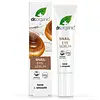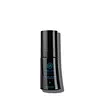What's inside
What's inside
 Key Ingredients
Key Ingredients

 Benefits
Benefits

 Concerns
Concerns

 Ingredients Side-by-side
Ingredients Side-by-side

Aloe Barbadensis Leaf Juice Powder
Skin ConditioningCarthamus Tinctorius Seed Oil
MaskingWater
Skin ConditioningOlea Europaea Fruit Oil
MaskingSnail Secretion Filtrate
Skin ConditioningGlycerin
HumectantGlyceryl Oleate Citrate
EmulsifyingAleurites Moluccanus Seed Oil
Skin ConditioningMagnesium Aluminum Silicate
AbsorbentMoringa Oleifera Seed Oil
EmollientOlea Europaea Leaf Extract
PerfumingZiziphus Jujuba Seed Extract
Skin ConditioningTocopherol
AntioxidantAscorbic Acid
AntioxidantCaprylic/Capric Triglyceride
MaskingXanthan Gum
EmulsifyingHydroxyacetophenone
AntioxidantLevan
Skin ProtectingDecyl Glucoside
CleansingSodium Phytate
Citric Acid
BufferingDehydroacetic Acid
PreservativePhenethyl Alcohol
MaskingBenzyl Alcohol
PerfumingPhenoxyethanol
PreservativeAloe Barbadensis Leaf Juice Powder, Carthamus Tinctorius Seed Oil, Water, Olea Europaea Fruit Oil, Snail Secretion Filtrate, Glycerin, Glyceryl Oleate Citrate, Aleurites Moluccanus Seed Oil, Magnesium Aluminum Silicate, Moringa Oleifera Seed Oil, Olea Europaea Leaf Extract, Ziziphus Jujuba Seed Extract, Tocopherol, Ascorbic Acid, Caprylic/Capric Triglyceride, Xanthan Gum, Hydroxyacetophenone, Levan, Decyl Glucoside, Sodium Phytate, Citric Acid, Dehydroacetic Acid, Phenethyl Alcohol, Benzyl Alcohol, Phenoxyethanol
Water
Skin ConditioningArgania Spinosa Kernel Oil
EmollientPolyglyceryl-6 Distearate
EmulsifyingJojoba Esters
EmollientPolyglyceryl-3 Beeswax
EmulsifyingCetyl Alcohol
EmollientVigna Aconitifolia Seed Extract
Skin ConditioningGlycerin
HumectantPropanediol
SolventOpuntia Ficus-Indica Seed Oil
EmollientNigella Sativa Seed Oil
EmollientCaprylhydroxamic Acid
1,2-Hexanediol
Skin ConditioningHydroxyacetophenone
AntioxidantCellulose
AbsorbentXanthan Gum
EmulsifyingLevan
Skin ProtectingDecyl Glucoside
CleansingOlea Europaea Leaf Extract
PerfumingPhenethyl Alcohol
MaskingZiziphus Jujuba Seed Extract
Skin ConditioningAscorbic Acid
AntioxidantCitric Acid
BufferingCitrus Aurantium Amara Peel Oil
Skin ConditioningCitral
PerfumingFarnesol
PerfumingGeraniol
PerfumingLimonene
PerfumingLinalool
PerfumingWater, Argania Spinosa Kernel Oil, Polyglyceryl-6 Distearate, Jojoba Esters, Polyglyceryl-3 Beeswax, Cetyl Alcohol, Vigna Aconitifolia Seed Extract, Glycerin, Propanediol, Opuntia Ficus-Indica Seed Oil, Nigella Sativa Seed Oil, Caprylhydroxamic Acid, 1,2-Hexanediol, Hydroxyacetophenone, Cellulose, Xanthan Gum, Levan, Decyl Glucoside, Olea Europaea Leaf Extract, Phenethyl Alcohol, Ziziphus Jujuba Seed Extract, Ascorbic Acid, Citric Acid, Citrus Aurantium Amara Peel Oil, Citral, Farnesol, Geraniol, Limonene, Linalool
Ingredients Explained
These ingredients are found in both products.
Ingredients higher up in an ingredient list are typically present in a larger amount.
Ascorbic Acid is is pure Vitamin C. This form makes up the largest amount of vitamin C found naturally in our skin.
Not only is vitamin C great for your overall health and immune system, it also has plenty of benefits on your skin.
Vitamin C is best used for brightening skin. It improves dark spots, acne scars, and hyperpigmentation. This is because it blocks the process of skin darkening when exposed to UV.
Remember: Vitamin C should not replace sunscreen!
Your skin uses vitamin C to build collagen. Collagen is one key component in having a strong skin barrier and plump skin. Vitamin C also plays a role in regulating collagen, thus making it effective in improving wrinkles and fine lines.
Ascorbic acid shows potent antioxidant activity. As an antioxidant, it helps fight free-radicals. Free-radicals are molecules that may damage your skin cells. These antioxidants also protect skin against UV damage.
The best formulations include Vitamin E and/or ferulic acid. These two ingredients help stabilize and provide a boost in the benefits of ascorbic acid. This is because ascorbic acid becomes unstable when exposed to UV and air. In fact, you can tell your ascorbic acid has oxidized when it turns an orange-yellow color.
Ascorbic acid is generally compatible with other ingredients. However, using ascorbic acid with other active ingredients might cause irritation. Two ingredients: copper ions and benzoyl peroxide, will inactivate ascorbic acid completely.
Read more about other types of Vitamin C:
Foods rich with vitamin C include oranges, strawberries, broccoli, bell peppers, and more. When consuming Vitamin C, your skin receives a portion of the nutrients.
Learn more about Ascorbic AcidCitric Acid is an alpha hydroxy acid (AHA) naturally found in citrus fruits like oranges, lemons, and limes.
Like other AHAs, citric acid can exfoliate skin by breaking down the bonds that hold dead skin cells together. This helps reveal smoother and brighter skin underneath.
However, this exfoliating effect only happens at high concentrations (20%) which can be hard to find in cosmetic products.
Due to this, citric acid is usually included in small amounts as a pH adjuster. This helps keep products slightly more acidic and compatible with skin's natural pH.
In skincare formulas, citric acid can:
While it can provide some skin benefits, research shows lactic acid and glycolic acid are generally more effective and less irritating exfoliants.
Most citric acid used in skincare today is made by fermenting sugars (usually from molasses). This synthetic version is identical to the natural citrus form but easier to stabilize and use in formulations.
Read more about some other popular AHA's here:
Learn more about Citric AcidDecyl Glucoside is a glucose-based surfactant and emulsion stabilizer. It is created by reacting glucose with the fatty acids from plants.
Surfactants help clean the skin by trapping oil, sebum, and dirt to be washed away. As an emulsion stabilizer, it stabilizes the ingredients in a product by preventing them from separating.
This ingredient is biodegradable and non-toxic. This ingredient is commonly found in baby shampoos.
Decyl Glucoside is sometimes used to stabilize the UV filter Tinosorb.
Learn more about Decyl GlucosideGlycerin is already naturally found in your skin. It helps moisturize and protect your skin.
A study from 2016 found glycerin to be more effective as a humectant than AHAs and hyaluronic acid.
As a humectant, it helps the skin stay hydrated by pulling moisture to your skin. The low molecular weight of glycerin allows it to pull moisture into the deeper layers of your skin.
Hydrated skin improves your skin barrier; Your skin barrier helps protect against irritants and bacteria.
Glycerin has also been found to have antimicrobial and antiviral properties. Due to these properties, glycerin is often used in wound and burn treatments.
In cosmetics, glycerin is usually derived from plants such as soybean or palm. However, it can also be sourced from animals, such as tallow or animal fat.
This ingredient is organic, colorless, odorless, and non-toxic.
Glycerin is the name for this ingredient in American English. British English uses Glycerol/Glycerine.
Learn more about GlycerinHydroxyacetophenone is antioxidant with skin conditioning and soothing properties. It also boosts the efficiency of preservatives.
This ingredient is not irritating or sensitizing.
We don't have a description for Levan yet.
Olive tree leaves contain more antioxidants than olive fruit.
This is due to its rich flavonoid and polyphenol content. However, the antioxidant content varies depending on plant variety, harvesting method, leaf maturity, and extraction method.
This ingredient also has a natural fragrance. Read more about fragrance in cosmetics here.
Learn more about Olea Europaea Leaf ExtractPhenethyl Alcohol is a colorless and aromatic alohol. It is naturally occuring in essential oils.
The scent of this ingredient is floral and often compared to rose.
Like other alcohols, this ingredient helps prevent the growth of bacteria. However, its main purpose is to impact a fragrance.
Learn more about Phenethyl AlcoholWater. It's the most common cosmetic ingredient of all. You'll usually see it at the top of ingredient lists, meaning that it makes up the largest part of the product.
So why is it so popular? Water most often acts as a solvent - this means that it helps dissolve other ingredients into the formulation.
You'll also recognize water as that liquid we all need to stay alive. If you see this, drink a glass of water. Stay hydrated!
Learn more about WaterXanthan gum is used as a stabilizer and thickener within cosmetic products. It helps give products a sticky, thick feeling - preventing them from being too runny.
On the technical side of things, xanthan gum is a polysaccharide - a combination consisting of multiple sugar molecules bonded together.
Xanthan gum is a pretty common and great ingredient. It is a natural, non-toxic, non-irritating ingredient that is also commonly used in food products.
Learn more about Xanthan GumWe don't have a description for Ziziphus Jujuba Seed Extract yet.